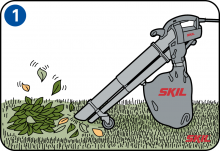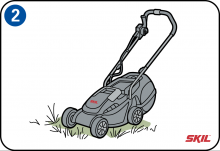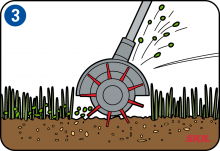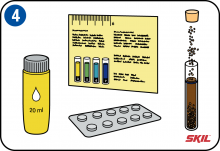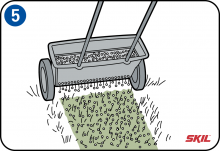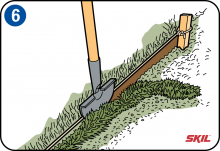-
Step 1: Remove all leaves and all other detritus from your lawn
Start by removing leaves and other detritus, such as twigs, from your lawn. A leaf blower will get the job done quickly. As well as (dead) leaves, a leaf blower can also suck up and cut up small pruning waste. This is deposited in a bag so it can be easily thrown away. -
Step 2: Mow the lawn one last time before winter
You can continue to mow your lawn until you see that the grass has stopped growing. The last mow of the year will be sometime at the end of October. We advise you to mow down to about 4cm (1.5 inches). If the grass is left a little longer over the winter it will be more resistant to moss growth. -
Step 3: Remove the moss
Scarifying your lawn in the autumn is recommended if moss growth is observed during the summer. A special lawn raker will easily remove the moss from the lawn. Then, simply rake together the moss and take it away. Removing the moss gives the grass more light and oxygen. Nutrients can more easily reach the grass, which is more important than ever in the autumn and winter. -
Step 4: Liming
Take the fight against moss and weeds in the winter to the next level by checking the acidity (pH value) of the soil. You should be able to get a soil test kit from a garden centre.
If the pH value is too low the grass will not be able to take up all the nutrients it needs, so it will grow more slowly. That gives moss the chance to grow between the grass. Liming will increase the pH value of the soil, making it less acidic. Use special lime for lawns, spreading it evenly at the onset of winter. You may want to repeat the process in mid-winter. You can lime even when there is snow on the ground. The lime will seep into the soil when the snow melts. -
Step 5: Fertilising
You can fertilise your lawn for the last time before winter around 6 weeks after liming. The extra nutrients in the soil ensure the grass is better protected against diseases, speed up its recovery and reduce the likelihood of moss forming over the winter.
Various types of fertiliser are available. They can be split into two main groups: organic fertiliser and artificial fertiliser. Artificial fertiliser is cheaper than organic fertiliser and contains all the minerals the lawn needs. Organic fertiliser only contains natural nutrients and it works longer than artificial fertiliser. Take note that most fertilisers contain substances that are harmful to children and pets. With this in mind, you should preferably keep children and pets away from the lawn for a few days to allow the fertiliser to penetrate into the soil. Always follow all instructions on the product packaging. -
Step 6: Trimming the edges of the lawn
Trimming the edges of your lawn will tidy it up going into the winter and prevent the grass overgrowing too much. Here’s what you do:
Step 1: Stretch a piece of string along the edges of the lawn
If you want to trim a straight stretch of lawn, you can just follow the string. Place two sticks at the ends of the edge of the lawn and then place any additional sticks in between. Now stretch a piece of string between them along the edge of the lawn. Make sure it’s stretched tight so that it cannot move.
Step 2: Trim along the edge
Now you can trim the edge using a special edge trimmer. Place the edge trimmer against the inside of the string. Make sure the edge trimmer is tilted in the ground so that the edge of the lawn remains firm and does not crumble away. Move the edge trimmer along the length of the string with a cutting motion.
Step 3: Rake together the lawn edges
Use a rake to gather together the edges that you have cut off.

